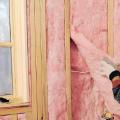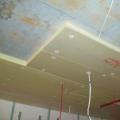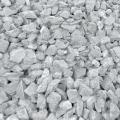Choosing the best option for insulating aerated concrete walls
You have built or bought your own home. Or you are just about to do it, planning your actions in advance. We weighed all the pros and cons and came to the conclusion that the building should be made of stone, and the walls should be built from a warm and efficient material: aerated concrete. It is also cellular concrete, gas silicate, foam concrete. Is there a need to insulate walls made of aerated concrete (“thermal fur coat”), and if so, how to do it correctly?
Video report on the thermal insulation of a house made of aerated concrete with ecowool
Reasons for insulation
It seems obvious: to keep the house warmer and lower heating costs. But you can just increase the thickness of the walls? Hard mineral wool, most suitable for insulating facades, with a slab thickness of 100 mm will cost (in the central regions of the country) an average of 450 rubles per m 2. In terms of thermal characteristics, this is an analogue of cellular concrete with a thickness of 300 mm. And it will cost 900 rubles. In fact, if you count the entire structure of external insulation: mineral wool boards, two layers of glue, fasteners, plaster, mesh, the price will rise to 800 rubles per meter and will practically be equal to the cost of increasing the heat-insulating properties of the wall by increasing the thickness of the masonry. However, under a thicker wall you will have to build a more powerful and expensive foundation. “Thermal fur coat” still turns out to be more profitable. The most rational option in terms of price/energy saving ratio for central Russia is a foundation 300 mm thick (preferably also insulated); walls made of aerated concrete 400 mm; insulation 100 mm.
The optimal insulation option: “thermal fur coat” using hard mineral wool slabs 100 mm thick
There is another important point: durability and the notorious dew point. Our continental climate is unfriendly to stone building materials. Moisture, getting into the internal pores of aerated concrete, freezes in cold weather, expands and gradually tears apart the walls. This applies not only to cellular concrete, but also to brick and concrete. In our area, a stone house will never last as long as, for example, in Southern Europe. If the Parthenon had been built in Moscow, it would have long ago fallen apart into separate pebbles. External insulation will again help to extend the life of a building so that it can be passed on intact to great-grandchildren.
In heating engineering there is such a concept: “dew point”. This is a place in the thickness of the wall material with zero temperature. It is in this zone that the maximum amount of moisture condenses and the material either freezes or thaws again. Dry blocks look and feel like they have an average moisture content of 5-8%. During the thawing-freezing process, this water little by little but inexorably wears away the stone of our walls. What's the solution?

Aerated concrete is hydrophobic (absorbs moisture) and it is not worth leaving a residential building unplastered for the winter, it will be damp
Remove the dew point from the wall, move it outward. That is, make sure that aerated concrete is constantly in the positive temperature zone, then it will last significantly longer. In addition, with the correct design, the wall will always be dry, which will create a healthy microclimate in the house. The fact that the dew point will completely shift into the insulation is not a problem. Firstly, it is an order of magnitude less susceptible to the destructive forces of freezing water. Secondly, unlike a main wall, insulation is easy to reconstruct.
Choose a method: outside or inside
We have already mentioned that the house should be insulated from the outside. But doing it from the inside is cheaper, easier and faster? Yes, but not so. Yes, there is no need to install scaffolding. Yes, you can use cheap soft glass wool and cover the walls with plasterboard, immediately completing the interior finishing. Yes, you can work under a roof in winter and in bad weather.
Alas, by doing insulation from the inside, we lose a lot. Firstly, we shift the “dew point” not outward, but, on the contrary, inside the wall. Thus, we only worsen the operating conditions of aerated concrete and reduce the durability of the building. Secondly, almost every building has so-called “cold bridges”. “Warm” walls made of cellular blocks also have “cold” elements: floor slabs, reinforced belts, lintels. They are more thermally conductive and through them cold penetrates into the house, and money evaporates from the house. Insulating aerated concrete walls from the outside solves this problem. The house, like a fur coat, is completely enclosed in a heat-insulated shell. The internal insulation is like a gill caftan with holes: the belly is warm, but the back is cold.
Let's summarize: internal insulation only partially solves the problem, the only correct option is external. It makes sense to insulate it from the inside if there is simply no other way out. For example, for some reason it is not possible to change the appearance of the facade.

Rigid mineral wool slabs are used for external insulation.
What material is better to use
The eternal question of all developers: mineral wool or polystyrene foam? Mineral wool is more expensive, but better. Polystyrene foam is cheaper, but worse. It’s like crayfish on Privoz: large ones cost five rubles, small ones cost three rubles. Let’s try to figure out why mineral wool is better and whether it’s worth overpaying for it:
- Mineral wool and expanded polystyrene are extremely similar in thermal characteristics. The latter is even a little more effective. Mechanical properties and durability are also not much different.
- Mice hate mineral wool and love polystyrene foam. If there is no finishing anywhere on the surface of the polystyrene foam boards, the Mickey Mouse family will immediately make a cozy hole there and settle in. But, if the facade is completely covered with plaster, this will not happen.
- It is much easier to work with polystyrene foam, it is easier to cut, and random cracks can be easily eliminated with construction foam. Mineral wool boards are a little more difficult to process and you will have to work with protective gloves, goggles and preferably a respirator.

Polystyrene foam is cheaper than mineral wool
- Mineral wool is an absolutely fireproof material. Expanded polystyrene does not support a flame; it cannot be set on fire. However, when exposed to fire, it releases poisonous gases, similar to those that the Germans used during the First Imperialist War. In fact, if you don’t light fires along the facade and don’t pour gasoline on the walls, there won’t be any problems.
- But in terms of vapor permeability, the materials differ radically. And this is important. Aerated concrete has optimal vapor permeability. A fairly large amount of moisture is constantly released inside a residential building. Cooking in the kitchen, washing machine, house flowers, wet cleaning. And people themselves give off moisture through their skin and breath. Aerated concrete is able to absorb this moisture and remove it through the pores of the material to the outside. The vector of vapor movement is always directed from the inside to the street. This phenomenon is called the “breathing” of the wall and it has a beneficial effect on the microclimate. By the way, cellular concrete is second only to wood in terms of vapor permeability and is considered one of the most human-friendly building materials.
Mineral wool fully supports the beneficial properties of aerated concrete. Being even more vapor-permeable, it does not prevent the walls from “breathing”. Polystyrene foam practically does not allow vapor to pass through. The house, insulated with polystyrene foam, is tightly packed, like a “stuff” in a plastic bag. Of course, you can ventilate the rooms by simply opening the window. Of course, on average, only 8% of moisture escapes through the walls in a “normal” house; the rest is removed by ventilation. However, the humidity of walls insulated with foam plastic still increases by 4-8%. Albeit insignificantly, but because of this, the thermal characteristics of aerated concrete are reduced and the housing microclimate worsens.

Mineral wool is preferable for insulating aerated concrete walls
Undoubtedly, mineral wool has a significant advantage and is the best material for external wall insulation. Undoubtedly, polystyrene foam is radically cheaper and also serves as a good insulator. Conclusion: if your budget allows, it is better to use mineral wool. If “finance sings romances,” you can insulate the house with polystyrene foam.
What should be the thickness of the insulation?
We often see how people insulate their houses with thin slabs of 4, 3 and even 2 centimeters. This is a big mistake. Even the use of the most common 5-centimeter slabs is not very justified.
The thicker the insulation layer, the warmer the house will be and the lower the cost of gas or firewood. Everyone understands this. But it is not clear to everyone that by reducing the thickness of the insulation by as much as 40% (from 5 to 3 cm), the total savings on the structure will be only a ridiculous 10%. After all, the cost of glue, plaster, mesh, fasteners and labor almost does not depend on the thickness of the insulation and cannot be significantly reduced. That is why there is nothing stupider than investing in related materials and saving on the main thing - the thickness of the insulation. The optimal, economically justified insulation of aerated concrete walls for the central regions of Russia is a 10 cm slab. It makes no sense at all to use material less than 5 cm thick.
“Wet” and “dry” insulation
We will not describe in detail the existing insulation methods. Manufacturers develop complex technologies and create clear, very detailed and well-illustrated manuals to help performers. They can be obtained from material sellers or downloaded online from original sites. Let us only mention that the instructions are written for a reason, and the technology must be followed strictly. Also, you should not try to replace any materials from complex systems with cheaper ones. For example, it happens that instead of special adhesive and plaster compositions, the cheapest tile adhesive is used for insulation. Yes, it will stick the slabs, but the service life and vapor permeability will be significantly lower than that of the “correct” composition.
- "Wet" system is lightweight
In fact, with the so-called “wet” technology, the facade remains completely dry. The insulation is fixed to the wall with glue and dowels with a large head. Then two thin leveling layers of plaster are applied, and a reinforcing plastic mesh is placed between them. Aerated concrete walls are smooth, there is no need to prepare them, just remove dust. Finishing - decorative plaster or light facing tiles made of porous ceramics or concrete.

One of the options for the “wet” system. You cannot skimp on dowels, corners and mesh.
- "Wet" system is heavy
If you really want to clad the facade with stone or heavy ceramic slabs, you will have to use “heavy” technology. In this case, the insulation is not glued, but attached to the wall with powerful hooks, a strong metal mesh is placed on top and the structure is fixed with metal plates. A thick (20-40 mm) layer of cement-sand plaster is applied over the mesh. Now you can place the stone. Such a system is significantly more expensive than a “light” one.
- "Dry" system
It is also called a ventilated or curtained façade. It involves installing a frame outside the facade, metal or wood. Insulation is placed between its elements - inexpensive soft mineral wool or even cheaper glass wool, polystyrene foam. The frame is sheathed with various materials: most often it is plastic or metal siding, wooden cladding board. Curtain facades made of porcelain stoneware or stone slabs, colored glass, roads and residential buildings are rarely used. A “dry” facade, if you do not use expensive types of cladding, is cheaper, but less attractive from an aesthetic point of view.

You must remember to leave an air gap of at least 2 cm between the insulation and the siding so that the walls have the opportunity to “breathe”
- Brick cladding
The last option is to cover the facade with brick. In this case, a frame is not needed; the insulation can be attached directly to the wall. An air gap should be left for ventilation of the insulation. Brick and the inevitable thickening of the foundation will cost a pretty penny.

To prevent the brick cladding from collapsing, it is secured to the main wall with anchors
To summarize, we get the following: the optimal solution in terms of price/efficiency/aesthetics ratio for temperate climatic zones of Russia is external insulation of aerated concrete walls with 10 cm thick mineral wool slabs using “wet” technology. Acceptable budget options are a “wet” foam facade or expanded polystyrene + plastic siding. Properly executed insulation of external walls will reduce heating costs by approximately half.
 Construction materials and list of works
Construction materials and list of works Proper insulation of a wooden ceiling in a private house
Proper insulation of a wooden ceiling in a private house What types of crushed stone are there?
What types of crushed stone are there?